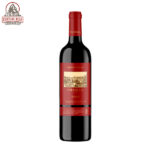Bergerac AOC
The Bergerac wine-growing region, a subregion of South West Francearound the town of Bergerac in the Dordogne department, comprises 93 communes. Its boundaries correspond more or less with those of the Arrondissement of Bergerac, immediately east of the Bordeaux wineregion. 1,200 wine-growers cultivate an area of 12,000 hectares (30,000 acres). The Bergerac area contains 13 Appellations d’origine contrôlées(AOCs) for red, white (dry, medium-sweet and sweet) and rosé wines.
The vineyards extend across the southern part of the Dordogne department, the Arrondissement (urban district) of Bergerac. Bergerac soil also features excellent drainage as a result of its proximity to the Dordogne River.
Approximately fifteen per cent of Bergerac AOC wine is sold outside France mainly to Great Britain, Belgium, Germany and the Netherlands.
The nature of the soils mirrors the extent of the wine-growing area.
The lacustrian calcareous source rock of the south-eastern area produces brown soil containing calcareous pebbles. The soil varies in thickness.
To the north of the River Dordogne, the source rock contains sands and clays mixed with gravel; the latter produce acid soils with a faded brown colour, while an accumulation of minerals deep below the surface create an impermeable sub-stratum known as “tran”.
In the south-east, boulbènes formed from sands and washed out silts result in a crusting soil that is poor in nutrients.
To the west, calcareous source rock that was once marine, produces brown soil containing calcareous pebbles. These are the same soils as those found in the wine-growing areas of the east Gironde, such as Saint-Émilion, Côtes de Castillon, Côtes de Franc.
During the Quaternary period, the River Dordogne deposited terraces of gravel alluvia on both banks. These soils are acidic and not particularly fertile, but they offer good drainage.
Grape varieties
The red wines are a blend of Cabernet Sauvignon, Cabernet Franc and Merlot, sometimes supplemented by Côt or, less commonly, by Fer Servadou or Mérille. They are often dark in color, with full-bodied flavours.
The white wines are mainly a blend of Sémillon with Sauvignon blanc, Sauvignon gris and Muscadelle, to which Ugni blanc, Ondenc and Chenin blanc are sometimes added. These combinations lead to the creation of fruity, dry white wines that can be powerful, and of medium-sweet or sweet wines that are aromatic and powerful.
Appellations
- Bergerac AOC: dry white wines, rosé wines and red wines. These are wines that can be enjoyed young (from two years old).
- Côtes de Bergerac AOC: mellow, soft red wines that can be stored. They only reach their prime after several years’ storage in the wine cellar.
- Montravel AOC: dry white wines and red wines.
- Haut-Montravel AOC: sweet white wines.
- Côtes de Montravel AOC: sweet white wines.
- Monbazillac AOC: white dessert wines that can be stored for a long time.
- Pécharmant AOC: red wines. These are wines suitable for medium-term storage.
- Rosette AOC: sweet white wines. This appellation, which is the smallest within the wine-growing area, produces little-known wines that are medium-sweet to sweet.
- Saussignac AOC: white dessert wines that can be stored medium to long-term.
Showing the single result






